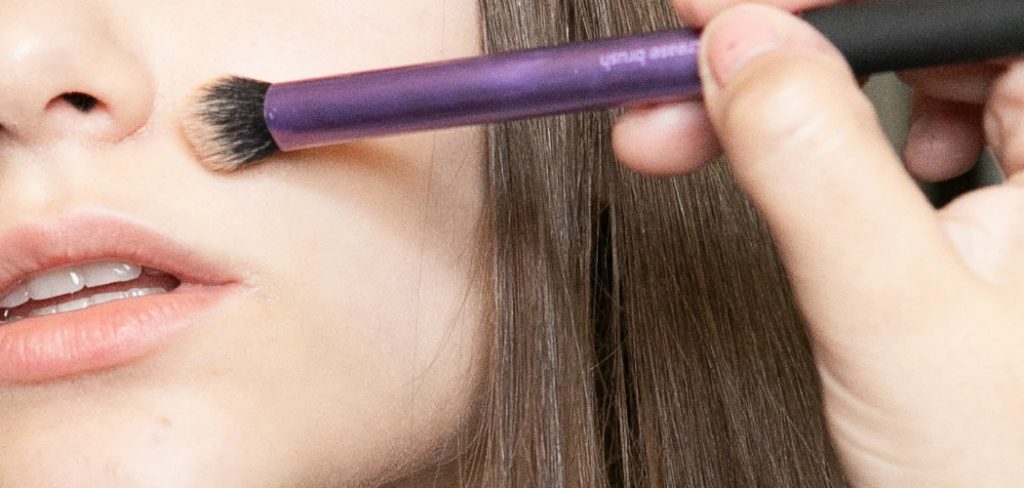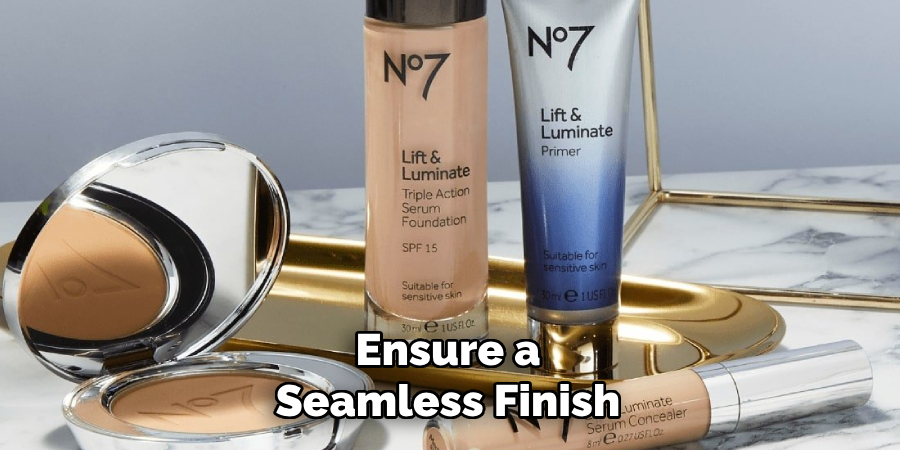Are you tired of your makeup smudging and melting off? Or are you looking for a way to make your foundation last longer? Setting powder may be just the solution you need!
How to apply setting powder is a crucial step in achieving a flawless and long-lasting makeup look. This versatile product helps to lock in your foundation and concealer, minimize shine, and create a smooth, matte finish. Whether you’re aiming for a natural glow or a dramatic evening look, knowing how to use setting powder properly can make all the difference.
With the right techniques and tools, you can ensure your makeup stays in place throughout the day, giving you a polished appearance no matter the occasion. Let’s dive into the steps to apply setting powder like a pro.

What Are the Benefits of Setting Powder?
Before we dive into how to apply setting powder, let’s first understand why it is an essential step in your makeup routine. Here are some key benefits that setting powder provides:
- Helps to lock in foundation and concealer, preventing them from settling into fine lines and creases.
- Absorbs excess oil and minimizes shine, giving you a matte finish.
- Creates a smooth base for other makeup products such as blush and bronzer.
- Can help makeup last longer throughout the day by providing a barrier against sweat and natural oils on the skin.
Now that we’ve covered the benefits of setting powder, let’s move on to the steps for proper application.
What Will You Need?
- Setting powder of your choice (loose or pressed)
- Powder brush or makeup sponge
- Translucent setting powder for all skin tones (optional)
- Makeup setting spray (optional)
9 Easy Steps on How to Apply Setting Powder
Step 1: Prepare Your Skin
Before applying setting powder, starting with a well-prepped canvas is essential. Begin by cleansing your face with a gentle facial cleanser suited for your skin type to remove any dirt, oil, or impurities. Follow up with a moisturizer to hydrate the skin, ensuring a smooth and even surface for your makeup.
Depending on your needs, you may also use a primer to blur imperfections, fill in fine lines, and help your makeup adhere better to the skin. Allow your skincare and primer to fully absorb before moving on to the next steps—this creates the perfect foundation for your setting powder to perform effectively.

Step 2: Apply Foundation and Concealer
Once your skin is prepped, it’s time to apply foundation and concealer. Choose a foundation that matches your skin tone and provides the coverage level you desire, whether it’s sheer, medium, or full coverage. Use a makeup sponge, foundation brush, or clean fingers to blend the product evenly over your face, focusing on areas that need extra coverage, like redness or uneven skin tone.
Next, apply concealer to target dark under-eye circles, blemishes, or discoloration. For the under-eye area, select a concealer that’s slightly lighter than your foundation to brighten and lift the area. Dab a small concealer on the target area and gently blend it using your ring finger, sponge, or a small brush. It’s essential to blend the edges well to avoid harsh lines.
Step 3: Choose the Right Setting Powder
Setting powder is a key step to ensure your makeup lasts longer, stays crease-free, and maintains a smooth finish throughout the day. Selecting the right setting powder depends on your skin type and preferred finish. For oily skin, a mattifying translucent powder helps control shine and keeps your makeup intact. If you have dry or combination skin, use a hydrating or satin-finish powder to avoid emphasizing dry areas while achieving a polished look.
Step 4: Add Dimension with Contour and Highlight
Contouring and highlighting help to define your features and add depth to your makeup look. To contour, choose a product one to two shades darker than your natural skin tone. Apply it to areas you want to define, such as the hollows of your cheeks, the jawline, and the sides of your nose.

Blend well to ensure a seamless finish. For highlighting, pick a product one to two shades lighter than your skin tone or has a subtle shimmer. Apply it to the high points of your face, including the tops of your cheekbones, the bridge of your nose, the brow bone, and the cupid’s bow. This will give your skin a radiant and illuminated appearance.
Step 5: Add Color with Blush
Blush brings a healthy, youthful glow to your face and ties your makeup look together. Choose a blush shade that complements your skin tone—peachy tones work well for warm undertones, while pink or berry shades suit cooler undertones. Apply the blush to the apples of your cheeks, blending it slightly upward toward your temples for a natural and lifted effect. Start with a light application and build up the intensity as needed to avoid overloading the color.
Step 6: Define Your Eyes
Defining your eyes can enhance your overall makeup look and make your features stand out. Start by applying a neutral eyeshadow base across your eyelids to create an even canvas. Then, choose a complementary eyeshadow shade to add depth and dimension—lighter colors on the lid and darker shades in the crease work well for a balanced look.
Use eyeliner to define the lash line, with a fine line for a subtle effect or a bolder shape for more drama. Finally, curl your lashes and apply mascara to give them volume and length, ensuring your eyes become a captivating focal point.
Step 7: Perfect Your Lips
Your lips are the finishing touch to your makeup look, tying everything together. Start by exfoliating and moisturizing your lips to create a smooth base for application. Use a lip liner to define the shape of your lips and prevent your lipstick from smudging or bleeding.
Choose a lip color that complements your overall makeup and outfit—neutral shades for a more natural look or bold colors to make a statement. Apply the lipstick with a brush or directly from the tube, and blot lightly with a tissue for a longer-lasting effect. For added shine, you can finish with a layer of lip gloss.
Step 8: Set Your Makeup
Setting is an essential final step to ensure your makeup stays flawless throughout the day or night. Use a setting spray or a translucent setting powder to lock everything in place. A setting spray helps keep your makeup intact and gives a fresh, dewy finish, while setting powder works excellently for reducing shine and achieving a matte appearance.
Lightly mist your face with the spray or gently dust the powder over your T-zone and other areas prone to oiliness. This step ensures your look remains polished and long-lasting, no matter the occasion.
Step 9: Final Touches
The final touches are what elevate your makeup look from excellent to flawless. Take a moment to check your makeup in natural light or with a bright mirror to ensure everything is blended seamlessly and there are no harsh lines. Add a pop of highlighter on the high points of your face, such as the cheekbones, brow bones, and the tip of your nose, for a radiant finish.

You can also touch up your eyebrows or adjust your eyeliner to perfect their shape. Finally, keep any essentials like lipstick or blotting papers on hand for quick touch-ups throughout the day. These small details can make a big difference in completing your look.
By following these steps and practicing your technique, you can achieve a flawless makeup look that enhances your natural beauty.
5 Things You Should Avoid
- Applying Too Much Product: Overloading your brush or sponge with setting powder can lead to a cakey and heavy look. A little goes a long way, so use a light hand and build up as needed.
- Skipping Proper Skin Preparation: Applying setting powder on dry or unprepped skin can emphasize texture and make the makeup look uneven. Always moisturize and prime your skin beforehand.
- Using the Wrong Tool: The choice of tool matters. Avoid using stiff brushes that can apply too much powder or sponges that might not distribute evenly. Opt for a soft, fluffy brush for a natural finish.
- Applying Powder to Wet Product: Adding setting powder before your foundation or concealer has fully set can cause clumping or patchiness. Always ensure your base is dry and blended before applying powder.
- Using the Wrong Shade of Powder: Incorrectly matched powders can alter the appearance of your foundation, either making it look too light or leaving a white cast in photos. Choose a translucent powder or one that closely matches your skin tone.

Conclusion
How to apply setting powder correctly can greatly enhance the longevity and finish of your makeup.
You can achieve a flawless, natural look by avoiding common mistakes such as using too much product, skipping skin preparation, or mismatching shades. Always take the time to blend your base products thoroughly, use a soft brush for application, and select a powder suited to your skin tone and type.
With a bit of attention to detail and proper technique, setting powder can become an essential tool in your makeup routine for a polished, camera-ready finish.
About the Author
Jane Hubbard is a passionate beauty expert with a wealth of experience in makeup, hair, and overall beauty techniques. After years of working as a hairdresser specialist, she followed her entrepreneurial spirit and started her own consultancy business.
Jane has always been driven by her desire to help others feel confident in their own skin, and she does this by sharing her knowledge, experiences, and practical beauty tips. Through her consultancy, she empowers individuals to embrace their unique beauty, offering tailored guidance that boosts both self-esteem and personal style.
Professional Focus
- Specializes in makeup, hairstyling, and beauty consulting.
- Provides personalized beauty advice, tips, and techniques to help individuals feel confident in their appearance.
- Dedicated to staying up-to-date with the latest industry trends and developments.
- Passionate about creating a comfortable and empowering experience for every client.
Education History
- University of Craft and Design – Bachelor of Fine Arts (BFA) in Woodworking and Furniture Design
- Woodworking Apprenticeships – Extensive hands-on training with skilled craftsmen to refine carpentry and furniture making techniques
- Online Courses & Masterclasses – Continued education in advanced woodworking techniques, design principles, and specialized tools
Expertise:
- Makeup artistry, hairstyling, and beauty consulting.
- Personalized beauty techniques to enhance confidence and self-expression.
- Educating clients on how to maintain their beauty routines at home.
